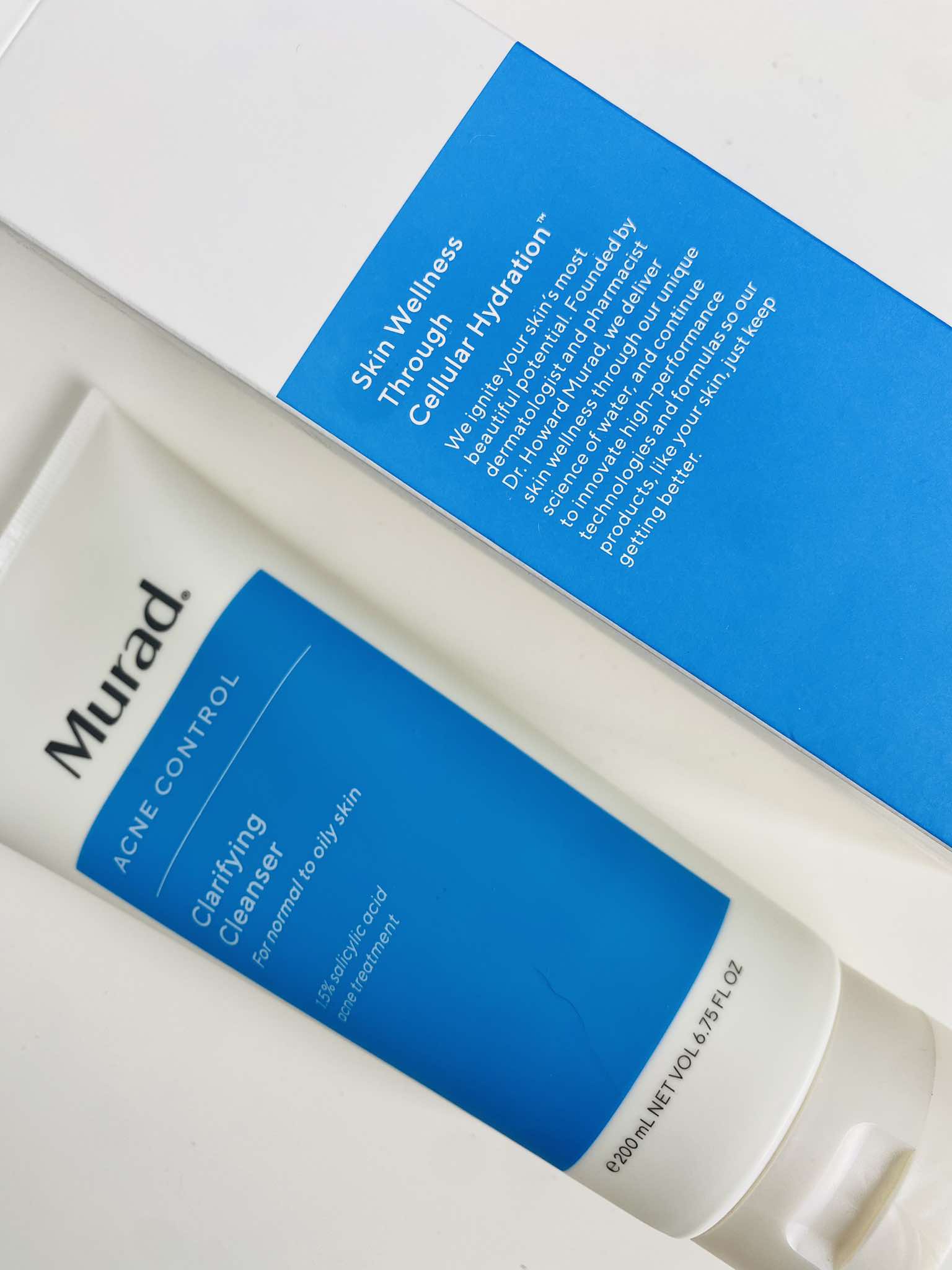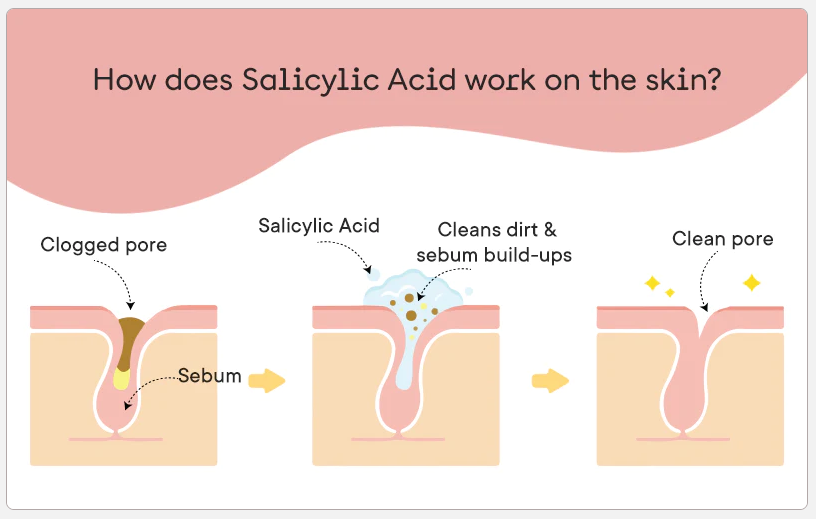Murad Time Release Acne Cleanser Reviews: My Experience
Brief overview: Murad Time Release Acne Cleanser
In this article, I will share both my experience as well as other Murad Time Release Acne Cleanser reviews (renamed to Acne Control Clarifying Cleanser). Though, firstly I will explore key features of the cleanser, and how the key active ingredient salicylic acid works in the formula to address issues for oily acne-prone skin.
Dr Howard Murad, a board-certified dermatologist and pharmacist, founded the brand Murad. Murad is renowned for its science-backed skincare products that address various skin concerns. Dr Murad’s extensive medical background informs the brand’s commitment to using clinically backed ingredients selected for their efficacy, quality, and origin. This commitment to quality, along with rigorous clinical studies conducted, justifies the premium price tag associated with Murad products.
Murad’s Time Release Acne Cleanser stands out as a unique product for those struggling with acne-prone skin. This cleanser combines potent ingredients to offer both immediate and long-term benefits.
Legal Disclaimer: This blog post is an unpaid, personal review of the Murad Time Release Acne Cleanser. I am not affiliated with or endorsed by Murad.
Murad Time Release Acne Cleanser: Features and Who It Is For
The Murad Time Release Acne Cleanser targets oily, acne-prone skin or stubborn skin concerns. It has a reputation amongst Murad Time Release Acne Cleanser reviews as one of the better choices of the numerous anti-acne cleanser options. This is due its efficacy and gentleness for sensitive skin.
Its time-release salicylic acid formula described below effectively targets breakouts whilst minimising irritation and future breakouts according to Murad.com. The gel cleanser contains a balanced blend of two types of salicylic acid. These work together with inactive ingredients to dissolve excess oil, unclog pores, and calm irritation.

Key Active Ingredient: Salicylic Acid
Before we delve into Murad Time Release Acne Cleanser reviews, let’s explore the key active ingredient. We will investigate salicylic acid and how it works in the cleanser.
Salicylic acid is a beta-hydroxy acid (BHA) that penetrates deeply to unclog pores. This is due its lipophilic nature, making it particularly suitable for oily, acne-prone skin.
One of the standout features of this cleanser is its inclusion of two forms of the active ingredient. It contains both the free form and encapsulated form of salicylic acid. The cleanser contains 0.5% salicylic acid in a free form for immediate exfoliation and 0.5% in an encapsulated form for sustained release.
Free-form salicylic acid
The free form of salicylic acid quickly binds to the stratum corneum, the outermost layer of the skin. Here, it begins to exfoliate dead skin cells and reduce sebum production.

Encapsulated Form Salicylic Acid
Meanwhile, the encapsulated salicylic acid slowly releases into the skin, even after rinsing the cleanser off. This is achieved through microencapsulation, whereby a biodegradable shell encloses the acid which gradually dissolves over time.

This slow-release mechanism allows the salicylic acid to continuously target deeper layers of the skin, specifically the epidermis. Here, it binds to keratin, and also dissolves the intercellular “glue” (desmosomes) that holds dead skin cells together. This allows them to shed more easily, preventing the buildup that can clog pores and lead to acne. It binds to keratin and helps clear out clogged pores throughout the day, helping prevent future breakouts.
Combining Salicylic Acid with Hydrating Ingredients
Why it is important
The formula blends salicylic acid with moisturising ingredients like humectants, which is crucial for maintaining the skin barrier. This combination ensures that while the salicylic acid exfoliates and treats acne, the humectants provide hydration. This helps prevent the skin from becoming overly dry or irritated, which is essential for those prone to acne.
Key hydrating ingredients in the Murad Time Release Acne Cleanser
Butylene glycol
One key ingredient, butylene glycol acts as a humectant, drawing moisture into the skin. Its structure includes both hydrophilic and hydrophobic components, hence allowing it to interact with both water and oil. This thereby enhances the penetration of other skincare ingredients by increasing their solubility and absorption into the skin.
In this way, butylene glycol supports the salicylic acid to penetrate deeper into the skin layers, thereby increasing their effectiveness in treating acne at the source.
Cocamidopropyl betaine
This is a surfactant derived from coconut oil. It creates a mild lather that cleanses the skin without stripping it of its natural oils.
Sodium hyaluronate
The inclusion of sodium hyaluronate, a form of hyaluronic acid, ensures that the skin remains hydrated and plump. This helps to counteract any potential dryness from the acne-fighting ingredients.
Other Inactive Ingredients in the Cleanser
| Category | Ingredient | Function |
| Exfoliants/Acids | Citric Acid, Salix Alba (Willow Bark), Glutamic Acid | Citric Acid is an alpha hydroxy acid (AHA) that exfoliates the skin. Willow Bark Extract contains natural salicylic acid. Glutamic acid is an amino acid that acts as a humectant to helps to maintain the skin’s hydration. |
| Cleansing Agents | Sodium Cocoyl Isethionate, Cocamidopropyl Dimethylamine, Disodium Cocoamphodiacetate | Gentle surfactants that help cleanse the skin by removing dirt, oil, and impurities without over-drying. |
| Moisturisers | Caprylyl Glycol, Glyceryl Stearate, Sodium PCA, Cetyl Alcohol, Capric Triglyceride | Moisturising agents that hydrate, condition, and soften the skin. Sodium PCA is a natural moisturising factor (NMF), while Caprylyl Glycol also has preservative properties. |
| Emulsifiers/Surfactants | PEG-150 Distearate, PEG-100 Stearate, Glycol Distearate, PPG-15 Stearyl Ether | Emulsifiers and surfactants that help mix oil and water-based ingredients, ensuring the product has a stable and smooth texture. |
| Botanical Extracts | Cimicifuga Racemosa Root Extract, Melaleuca Alternifolia (Tea Tree Oil), Serenoa Serrulata Fruit Extract | These extracts provide various benefits such as soothing the skin, antibacterial properties (Tea Tree Oil), and antioxidant effects. |
| Chelating Agents | Disodium EDTA | Binds to metal ions in the formula, improving stability and preventing the product from degrading due to trace metals. |
| Antioxidants | Tocopheryl Acetate (Vitamin E), Argania Spinosa Kernel Oil (Argan Oil), Propyl Gallate | Antioxidants that protect the skin from free radicals and oxidative stress, supporting skin repair and reducing the signs of aging. |
| Preservatives | Silver Citrate | An antimicrobial agent that preserves the product by preventing the growth of bacteria and mould. |
| Other | Zea Mays (Corn) Starch, Hydrolyzed Corn Starch Octenylsuccinate | Used for thickening, oil absorption, and providing a smooth feel on the skin. |
My Murad Time Release Acne Cleanser Review
Initial Impression
Upon first use, the Murad Time Release Acne Cleanser felt incredibly high-quality. It is advised to use the cleanser on a dampened face. After use in the evening, my combination-oily skin, particularly congested areas like my nose and T-zone, felt noticeably cleaner compared to other cleansers, without being dry.
I was incredibly impressed by these results. My skin is normally quite oily by the end of the day. Some other cleansers do not effectively remove the build-up particularly on my nose.
Instead, my skin felt soft, supple, and healthier-looking. The product induced a slight cooling sensation, but not as intensely as others, like the Soap and Glory cleanser.
Dry Skin
However, a few days into my regimen, I noticed dry skin around my chin and other areas. It’s important to mention that I was also trialing another product containing micronised benzoyl peroxide. This ingredient is known for its drying effects. Concerned, I paused my use of the Murad cleanser.
After a week, I resumed using the cleanser, this time on its own. My plan was to trial whether my skin could tolerate the salicylic acid cleanser at least once a week. Though, to my relief, I experienced no further dryness in subsequent days. Now, I have been using the Murad Cleanser for months with great results. While I still use a chemical AHA exfoliant once or twice a week to deeply clean my pores, the time-release salicylic acid in this cleanser has undoubtedly helped manage my acne over the longer term.
My acne and skin clarity results
Is Murad clarifying cleanser good for acne?
My skin’s overall appearance has improved. I still develop breakouts, though less frequently. For existing acne lesions, such as an inflamed, raw red spot I had, I noticed that after using the cleanser, it appeared more healed and less red the next morning.
It’s possible that this happened because salicylic acid, in the early stages of acne formation, helps reduce the inflammation by inhibiting pro-inflammatory cytokine production. This action can potentially reduce the redness and swelling associated with acne, particularly in early-stage inflammation. However, it may take longer for more severe or established inflammation to show improvement.
However, results regarding unclogging pores and preventing future breakouts are not expected to be immediate. It typically takes about 6 to 8 weeks to see noticeable results from salicylic acid in the longer term.
I also found that balancing other lifestyle factors has been effective, such as reducing sugar intake by avoiding desserts. This has very quickly led to clearer skin and far less new breakouts.
Note on Skin Sensitivity
Additionally, for your reference, I do have sensitive skin. My skin cannot tolerate the active form of Vitamin C (ascorbic acid) in skincare, or benzoyl peroxide which induces red patchiness. Though note that salicylic acid is known to be more gentle than benzoyl peroxide. However, individual sensitivities may vary.
However, salicylic acid has been known to trigger reactions for some people with sensitive skin. Always proceed with caution when trialling new products and seek professional dermatological advice if in doubt.
Other Murad Time Release Acne Cleanser Reviews
Sources include reviews from Sephora, Ulta, Dermstore, and Reddit’s SkincareAddiction.
- Positive Reviews: People often report that the cleanser effectively cleanses without overly drying, with the time-release salicylic acid providing continuous acne treatment throughout the day.
- Mixed Reviews: Some people, particularly those new to salicylic acid or with sensitive skin, initially experienced dryness or irritation, which usually improved over time. However, others have pointed out that, whilst effective, the cleanser may not be strong enough for those with a severe acne issue.
- Negative Reviews: A few people mentioned dryness, particularly on the chin, especially when using the cleanser alongside other acne treatments.
Final Thoughts
In conclusion, the Murad Time Release Acne Cleanser is a powerful addition to any acne regimen. Its carefully selected ingredients work synergistically to combat breakouts, improve the skin’s texture, and maintain hydration. Although it may initially cause dryness, especially when combined with other active products, it can be an effective tool for achieving clearer, healthier-looking skin when used correctly. I am already beyond my first bottle of this face wash that is the best cleanser I have come across thus far. I am keen to trial other Murad skin care products.
If you are interested to try the product, the Murad Time Release Acne Cleanser typically comes in a 6.75 fl oz (200 ml) bottle. It is also available in Murad’s travel size form, often in a 1.0 fl oz (30 ml) bottle.
Keep in mind that a salicylic acid skin care product should be followed up with a moisturiser for oily acne prone skin, and a sunscreen that does not clog pores.

Leave A Comment